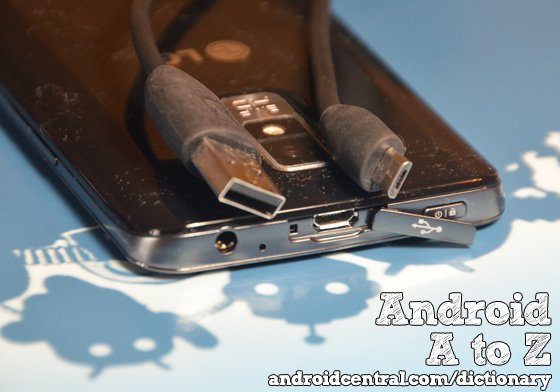What is USB? [Android A to Z]

What is USB? USB stands for Universal Serial Bus, and is a standard for connectors, cables and protocols used for data transfer and power between a computer and another electronic device. It was developed in 1995 to allow a single connection method for things like computer keyboards, mice, and printers as well as connected devices like mp3 players and cameras. A standard USB interface has four wires (USB 3.0 has eight for double the data transfer), with two acting as power leads and two for data transfer. Commercial applications have up to eight wires and connection points, and can also provide 12- or 24-volt power in addition to the normal 5 volts. You'll see these sort of systems in cash registers and commercial barcode scanners.
What we're most interested in is the implementation in mobile devices. Most mobile devices in the world use USB 2.0 for data transfer and/or power supply. In China, laws have been passed making manufacturers keep to the USB standard for data transfer and power, and in December 2011 a law was written that all mobile phones will be able to use the same charger, with micro-USB as the standard, by the European Committee for Electrotechnical Standardisation. This only affects phones -- tablets and laptops are exempt because they have different power requirements.
Most new Android phones you'll buy have a microUSB (like the picture above) connector. The data cable will have a small plug to insert into the phone on one end, and a standard USB connector to plug into your computer. This cable will allow for data transfer -- to copy pictures or music or do a little hacking, as well as 5 volts to charge the device. Some older models have a miniUSB connector, which does the same thing but with a different, slightly larger, port. MicroUSB is a more robust connector, being rated at 10,000 "insertion cycles" so both the port on the phone as well as the cable should last longer. Some devices need a non-standard USB connector, like the Galaxy Tab 10.1 (or nearly every other Android tablet). Internal design doesn't permit a standard microUSB connector to fit on the board, so a wider, thinner plug and port combo was used. Also, some tablets can't get power fast enough to charge via a USB connector and use a separate DC socket and adapter for charging. For devices like the iPhone that have a non-standard connection port, an adapter can be made to allow them to comply with European mandates of a single charger solution.
Lastly, some phones use the microUSB interface for other things besides data transfer and power. Seeing HDMI output provided through a MHL (Mobile High-definition Link) is becoming pretty common, and allows a special adapter to be used to provide high definition video to stream out to televisions or computer monitors. These adapters can be purchased for about 15 dollars (US) and allow a standard HDMI cable to connect to your phone.
We've seen other connection methods come and go, and new ones are always being worked on, but USB offers relatively high-speed data transfer, is adaptable for various power needs, and is likely to stick around for a long time.
Previously on Android A to Z: What is tethering?; Find more in the Android Dictionary
More from the Android Dictionary
[block:views:article_lister_bespoke-block_13]
Be an expert in 5 minutes
Get the latest news from Android Central, your trusted companion in the world of Android

Jerry is an amateur woodworker and struggling shade tree mechanic. There's nothing he can't take apart, but many things he can't reassemble. You'll find him writing and speaking his loud opinion on Android Central and occasionally on Threads.